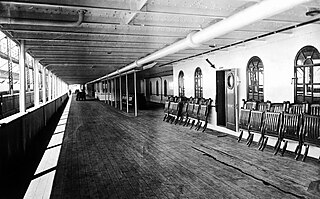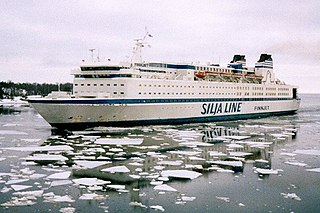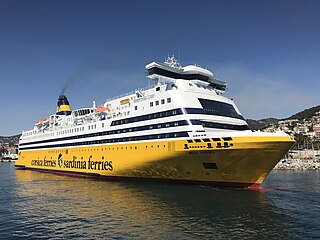Related Research Articles
Silja Line is a Finnish cruiseferry brand operated by the Estonian ferry company AS Tallink Grupp, for car, cargo and passenger traffic between Finland and Sweden.
Viking Line Abp is a Finnish shipping company that operates a fleet of ferries and cruiseferries between Finland, the Åland Islands, Sweden and Estonia. Viking Line shares are quoted on the Helsinki Stock Exchange. Viking Line is operated from Åland.

A passenger ship is a merchant ship whose primary function is to carry passengers on the sea. The category does not include cargo vessels which have accommodations for limited numbers of passengers, such as the ubiquitous twelve-passenger freighters once common on the seas in which the transport of passengers is secondary to the carriage of freight. The type does however include many classes of ships designed to transport substantial numbers of passengers as well as freight. Indeed, until recently virtually all ocean liners were able to transport mail, package freight and express, and other cargo in addition to passenger luggage, and were equipped with cargo holds and derricks, kingposts, or other cargo-handling gear for that purpose. Only in more recent ocean liners and in virtually all cruise ships has this cargo capacity been eliminated.

The promenade deck is a deck found on several types of passenger ships and riverboats. It usually extends from bow to stern, on both sides, and includes areas open to the outside, resulting in a continuous outside walkway suitable for promenading, thus the name.

MS Estonia was a cruiseferry built in 1980 at the West German shipyard Meyer Werft in Papenburg. In 1993, she was sold to Nordström & Thulin for use on Estline's Tallinn–Stockholm route. The ship's sinking on 28 September 1994, in the Baltic Sea between Sweden, Finland and Estonia, was one of the worst maritime disasters of the 20th century, claiming 852 lives.

MS Silja Europa, owned and operated by Tallink, is one of the largest cruiseferries in the world. She was built at Meyer Werft in Papenburg, Germany for the Swedish ferry operator Rederi AB Slite, a part of Viking Line. The main architect was Per Dockson.

GTS Finnjet was a cruiseferry, built in 1977 by Wärtsilä Helsinki Shipyard, Finland for Finnlines traffic between Finland and Germany. At the time of her delivery, Finnjet was the fastest, longest and largest car ferry in the world, and the only one powered by gas turbines. At the point of her scrapping in 2008, she remained the fastest conventional ferry in the world, with a recorded top speed of 33.5 knots.

MS Silja Serenade is a cruiseferry owned by the Estonian shipping company Tallink Grupp, operating under their Silja Line brand on a route connecting Helsinki to Stockholm via Mariehamn. She was built in 1990 by Masa-Yards at Turku New Shipyard, Finland. From 26 June 2020, to 13 September 2020, the ship's route was Helsinki–Riga, which got replaced by the cruiseferry MS Baltic Queen.

Mega Andrea is a cruiseferry owned and operated by Corsica Ferries Sardinia Ferries. She was formerly owned and operated by the Estonia-based Tallink as the MS Silja Festival, and used on their route connecting Riga, Latvia to Stockholm, Sweden. She was built in 1986 by Wärtsilä Helsinki Shipyard, Finland, for Effoa as MS Wellamo for use on Silja Line traffic. She was rebuilt in 1992 at Lloyds Werft, Bremerhaven, Germany as Silja Festival. In 2008 the ship was transferred from the Silja Line fleet to that of Tallink, but she retained her Silja-prefixed name. After being replaced by MS Isabelle on the Stockholm-Riga route in May 2013 she was chartered as an accommodation ship to Kitimat, British Columbia. She was then sold in early 2015 to Corsica Ferries.

Celestyal Crystal, previously Louis Cristal, is a cruise ship operated by the Cyprus-based Celestyal Cruises and previously Louis Cruise Lines, both in the Louis Group. The ship was originally built as the cruiseferry MS Viking Saga in 1980 at Wärtsilä Perno Shipyard and Turku Shipyard, Turku, Finland for Rederi Ab Sally. In 1986 she was renamed MS Sally Albatross, and rebuilt into a cruise ship the following year. The ship was destroyed by a fire in 1990, and completely rebuilt at Finnyards, Rauma, Finland. She was re-delivered in 1992, still named Sally Albatross. After partially sinking 1994 she was rebuilt at Industrie Navali Meccaniche Affini, La Spezia, Italy, re-entering service as MS Leeward for Norwegian Cruise Line. Subsequently she sailed as MS SuperStar Taurus for Star Cruises, MS Silja Opera for Silja Line and spent a year laid up as MS Opera prior to entering service with her current owner in 2007.

A cruiseferry is a ship that combines the features of a cruise ship with a Ro-Pax ferry. Many passengers travel with the ships for the cruise experience, staying only a few hours at the destination port or not leaving the ship at all, while others use the ships as means of transportation.

MS Bore is a combination museum and hotel ship docked permanently in Turku, Finland. She was originally built in 1960 by Oskarshamn shipyard, Oskarshamn, Sweden as the car/passenger ferry SS Bore for Steamship Company Bore, Finland, then the last commercial steam ship built in Scandinavia and the first ferry on the route between Finland and Sweden where cars could drive aboard. She was later known as SS Borea, before being rebuilt as a cruise ship in 1988. 1988 to 2010 she was owned by the Finnish shipping company Kristina Cruises and known as MS Kristina Regina until she was retired because she did not comply with new safety regulations.
Wasaline, previously Oy Vaasa-Umeå Ab (1948–1965), Vaasa-Umeå AB (1965–1979), Oy Vaasanlaivat – Vasabåtarna Ab (1979–1991) and Wasa Line (1991–1993) are different names for the Finnish shipping company that ceased trading in 1993 when it merged into Silja Line. Since 2013 the name is being used by a new company that operates between Vaasa (homebase) and Umeå.

MS Arberia was a cruiseferry owned by Chryses Finance Co. and operated by Ilion Lines on their Trieste–Durres–Bari service. She was built in 1975 by Dubegion-Normandie, Nantes, France as Bore Star for Steamship Company Bore, which used her in Silja Line services on the Baltic Sea. During the northern hemisphere winter months she was chartered to Finnlines for cruise services on the African west coast. In 1980 she was sold to Finland Steamship Company and renamed Silja Star but retained in Silja Line service. Between 1986 and 1992 she was used in different cruise and ferry services around the world for various operators under the names Orient Express, Club Sea, Eurosun and Orient Sun. In 1992 her ownership passed to Wasa Line and she was renamed Wasa Queen for Baltic Sea ferry service. In 1993 Wasa Line was merged into Silja Line and Wasa Queen returned to the Silja Line fleet. In 2001 she was sold to Star Cruises for use in Far Eastern ferry services and later casino cruising with its daughter company Cruise Ferries without a change in name. In 2008 Wasa Queen was withdrawn from service and in 2009 sold to her current owners.

MS Svea Corona was a car-passenger ferry built in 1975 by Dubegion-Normandie S.A., Nantes, France for Rederi AB Svea, Sweden for Silja Line traffic. She was later rebuilt as a cruiseship and known under names MS Sundancer and MS Pegasus. She was scrapped in 1995 in Aliağa, Turkey.
The Elmer A. Sperry Award, named after the inventor and entrepreneur, is an American transportation engineering prize.

Commodore Cruise Line was a United States -based cruise line that was in operation from 1968 until 2001. It was founded in 1966 by Sanford Chobol and Edwin Stephan. Following multiple changes in ownership, the company declared bankruptcy in 2001 due to rising fuel costs and increased competition from other cruise lines. It had its headquarters in Hollywood, Florida.

The Olympia Terminal is a dock in the South Harbour of Helsinki, Finland. It was designed by the Hytönen-Luukkonen architects bureau and opened for the 1952 Summer Olympics.

MS Sunward was a cruise ship built in 1966 for Knut Kloster. Originally designed and built for ferrying passengers and vehicles around the Bay of Biscay and Gibraltar, the promise and success of the Sunward would be short-lived. English currency restriction and the border closing between Spain and Gibraltar defeated the newly built ship's initial purpose. Ted Arison, an Israeli businessman, contacted Kloster about the possibility of converting the Sunward into a cruise ship in Miami. The Sunward operated as a cruise ship under the newly established Norwegian Caribbean Line. The ship proved to be such a success that Norwegian Caribbean Line commissioned newer, larger ships for its fleet, ultimately replacing the Sunward. She was sold to Compangnie Generale Transméditerranéenne in 1973, and later on with several companies. In 2004, the former Sunward was sold to Bangladeshi breakers for scrap. The vessel appeared in the 1970 dramatic film, "Darker than Amber" and the 1989 comedy "Going Overboard".
References
- 1 2 3 4 Franklin-Wallis, Oliver (April 1, 2018). "The dizzying story of Symphony of the Seas, the largest and most ambitious cruise ship ever built". Wired .
- 1 2 "Harri Kulovaara". Royal Caribbean Cruises Ltd. Retrieved May 11, 2018.
- 1 2 Aaron Saunders (1 October 2013). Giants of the Seas: The Ships that Transformed Modern Cruising. Seaforth Publishing. p. 93. ISBN 978-1-84832-172-4.
- ↑ Lloyd's Ship Manager and Shipping News International. Lloyd's of London Press. 1990. p. 55.
According to Harri Kulovaara, senior vice president of Eff John International, which manages all Effoa and Johnson Line ferries
- ↑ Society of Naval Architects and Marine Engineers (February 21, 2017). "2016 Elmer A. Sperry Award - Harri Kulovaara". Vimeo.